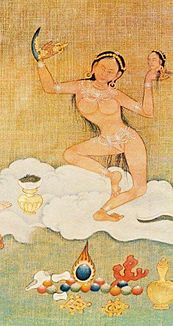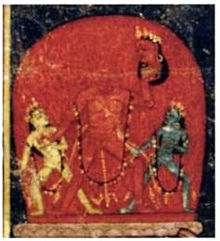179:
117:), who married them to sons of a boatman. Their husbands taunted them and their neighbours gossiped about them. Finally, Kanakhala could not take the abuse any more and suggested to Mekhala that they should flee their house. However, the wise Mekhala told her younger sister that they deserved it and would have to face the same torment somewhere else if they run away, so they stayed and bore the agony.
34:
25:
235:, who mocked them as disciples of Kanhapa and asked them to show a magic trick. The sisters with their powers moved the house of Gorakhnath's disciples to an arid desert from the picturesque setting it was at previously. Repentant, the yogis begged for forgiveness; the sisters relented and restored their dwelling to its former location.
190:
The legend of the sisters is associated with
Chinnamunda or Sarvabuddhadakini, the severed headed form of the goddess Vajrayogini or her form Vajravarahi. The nude self-decapitated goddess, standing in a fighting posture, holds her own severed head in one hand, a knife in another. Three jets of blood
269:
is supported in the crook of her left arm. Kanakhala holds her own severed head in her left hand and a sword or a kartika in her right. Kanakhala's head may be intact over her neck or she may be beheaded. In combined portrayals of the dancing sisters, Kanhapa may be depicted with one of sisters'
143:
The sisters journeyed to meet their guru to seek further instruction. They bowed to him and circumambulated him in reverence, however the daka failed to recognize them. They introduced themselves as the married unhappy sisters he had initiated twelve years ago. He responded that if he was their
238:
After 12 years, the sisters sought to meet their guru. They found
Kanhapa in Bengal, however the guru failed to recollect his meeting with them. Upon his request, the sisters drew swords of wisdom from their mouths and severed their heads and offered them to Kanhapa. The headless sisters danced
223:
The sisters surrendered to
Kanhapa, who had arrived in the region then. Kanhapa considered them fit disciples and trained them. They remained with his entourage for a few days. Kanhapa taught them the sadhana of Vajravarahi and sent them to a forest to practise in solitude. They attained many
270:
heads by his side; the sisters may not be beheaded in the portrayal. In a painting, where
Kanakala is depicted headless, three streams of blood gush from her neck. One stream of blood is drunk by Kanakhala's head in her hand; the others are collected in the skull-cups of Mekhala and Kanhapa.
147:
The sisters unquestioningly decapitated themselves and offered their severed heads at his feet. Their bodies danced as their severed heads sang reverently. The guru rejoined their heads and torsos. They were known as the "Headless
191:
spurt out of her bleeding neck and are drunk by her severed head and two dakini attendants, Vajravairocani and
Vajravarnini. The attendants hold a skull and a knife. This form is almost identical to the Hindu goddess
86:(Krishnacharya). They are said to have severed their heads and offered them to their guru, and then danced headless. Their legend is closely associated with the Buddhist severed-headed goddess
113:
Mondup Sherab, which was narrated to him by
Abhayadattashri c. 12th century) narrates the following tale: Mekhala and Kanakhala were daughters of a householder in Devīkoṭṭa (now in
257:
Mekhala and
Kanakhala may be depicted nude or topless. In combined portrayals, Mekhala is on the left. Both wear various gold ornaments and tiara-like headgear. Mekhala holds a
254:
Mekhala and
Kanakhala are depicted with swords held above their heads or dancing with them. They may be also depicted in the act of decapitation.
220:
boys, however were not married to them after they reached puberty and finally their marriages broke. Their neighbours gossiped about the same.
212:(a biography of Kanhapa) describes the life of some of his disciples including Mekhala and Kanakhala. The sisters lived in south of
278:
Mekhala and
Kanakhala are dated to the late ninth century based on the dating of their guru Krishnacharya, identified with Kanhapa.
144:
guru, they should have brought him offerings. The sisters asked him his desired offerings. The guru promptly asked for their heads.
242:
The self-decapitation of
Mekhala and Kanakhala started a dangerous trend of self-decapitation by dakinis. Ultimately, the goddess
166:
After serving the beings of the world for several years, they bodily assumed Khechara, the Paradise of dakinis governed by
382:
357:
323:
71:– "Younger Mischievous Girl") "The Younger Severed-Headed Sister") are two sisters who figure in the eighty-four
415:
261:
in her left hand, while she draws the sword from her mouth with her right hand or simply holds a sword or a
609:
436:
246:
herself appeared in this form as Chinnamunda and danced with the dakinis to stop further head-chopping.
128:. The sisters prostrated to the guru and explained their anguish. Kanhapa instructed them in the
216:. When Mekhala and Kanakhala when 10 and 8 years old respectively, they were betrothed to young
407:
400:
102:
140:. The sisters practised the meditative techniques for 12 years and accomplished their goal.
604:
266:
8:
243:
133:
411:
378:
353:
319:
110:
313:
262:
57:
or Mahakhala – "Elder Mischievous Girl") "The Elder Severed-Headed Sister" and
598:
572:
513:
315:
Masters of Mahamudra: Songs and Histories of the Eighty-Four Buddhist Siddhas
192:
129:
554:
536:
495:
477:
454:
66:
52:
213:
183:
167:
137:
87:
232:
160:
72:
202:
76:
196:
79:
124:
passed by their house with his retinue of seven-hundred dakas and
217:
121:
83:
258:
155:
149:
125:
114:
178:
239:
rising upward in the sky and disappeared in a rainbow light.
82:. Both are described as the disciples of another mahasiddha,
33:
228:
24:
186:
is associated with the legend of Mekhala and Kanakhala.
437:"The yidam – Vajrayogini | Tsem Rinpoche's Resources"
573:"Indian Adept (siddha) – Kanakhala (HimalayanArt)"
555:"Indian Adept (siddha) – Kanakhala (HimalayanArt)"
537:"Indian Adept (siddha) – Kanakhala (HimalayanArt)"
399:
375:Vajrayogini: Her Visualization, Rituals, and Forms
350:Chinnamasta: The Aweful Buddhist and Hindu Tantric
596:
514:"Indian Adept (siddha) – Mekhala (HimalayanArt)"
496:"Indian Adept (siddha) – Mekhala (HimalayanArt)"
478:"Indian Adept (siddha) – Mekhala (HimalayanArt)"
455:"Indian Adept (siddha) – Mekhala (HimalayanArt)"
173:
99:The Legends of the Eighty-four Mahasiddhas
16:Two mahasiddha sisters in Tantric Buddhism
159:(supernatural magical powers) and became
152:" henceforth. By this act, they acquired
177:
406:. Princeton University Press. pp.
372:
107:grub thob brgyad bcu tsa bzh'i lo rgyus
597:
352:. Motilal Banarsidass. pp. 9–10.
347:
311:
42:Sisters Mekhala and Kanakhala dancing
397:
343:
341:
339:
337:
335:
307:
305:
303:
301:
299:
297:
295:
293:
291:
132:(spiritual practice) of the goddess
377:. Simon and Schuster. p. 101.
13:
14:
621:
332:
288:
32:
23:
348:Benard, Elisabeth Anne (2000).
318:. SUNY Press. pp. 317–20.
424:
391:
366:
249:
1:
398:Shaw, Miranda Eberle (2006).
281:
174:Association with Chinnamunda
7:
402:Buddhist Goddesses of India
373:English, Elizabeth (2002).
67:
53:
10:
626:
273:
93:
441:resources.tsemtulku.com
227:Once, they encountered
195:, who is standing on a
312:Dowman, Keith (2010).
187:
136:, a ferocious form of
181:
577:www.himalayanart.org
559:www.himalayanart.org
541:www.himalayanart.org
518:www.himalayanart.org
500:www.himalayanart.org
482:www.himalayanart.org
459:www.himalayanart.org
210:Kahna pa 'i mam char
120:The mahasiddha guru
610:Vajrayana and women
205:(1575–1634) in his
75:("great adept") of
207:Historical Works -
188:
197:copulating couple
109:, written by the
617:
589:
586:
584:
583:
568:
566:
565:
550:
548:
547:
527:
525:
524:
509:
507:
506:
491:
489:
488:
468:
466:
465:
450:
448:
447:
428:
422:
421:
405:
395:
389:
388:
370:
364:
363:
345:
330:
329:
309:
70:
56:
36:
27:
625:
624:
620:
619:
618:
616:
615:
614:
595:
594:
593:
592:
581:
579:
571:
563:
561:
553:
545:
543:
535:
522:
520:
512:
504:
502:
494:
486:
484:
476:
463:
461:
453:
445:
443:
435:
431:Combined images
429:
425:
418:
396:
392:
385:
371:
367:
360:
346:
333:
326:
310:
289:
284:
276:
252:
176:
96:
46:
45:
44:
43:
39:
38:
37:
29:
28:
17:
12:
11:
5:
623:
613:
612:
607:
591:
590:
588:
587:
569:
551:
529:
528:
510:
492:
470:
469:
451:
423:
416:
390:
383:
365:
358:
331:
324:
286:
285:
283:
280:
275:
272:
251:
248:
175:
172:
95:
92:
41:
40:
31:
30:
22:
21:
20:
19:
18:
15:
9:
6:
4:
3:
2:
622:
611:
608:
606:
603:
602:
600:
578:
574:
570:
560:
556:
552:
542:
538:
534:
533:
532:
519:
515:
511:
501:
497:
493:
483:
479:
475:
474:
473:
460:
456:
452:
442:
438:
434:
433:
432:
427:
419:
413:
409:
404:
403:
394:
386:
384:9780861713295
380:
376:
369:
361:
359:9788120817487
355:
351:
344:
342:
340:
338:
336:
327:
325:9781438401485
321:
317:
316:
308:
306:
304:
302:
300:
298:
296:
294:
292:
287:
279:
271:
268:
264:
263:kartika knife
260:
255:
247:
245:
240:
236:
234:
231:disciples of
230:
225:
221:
219:
215:
211:
208:
204:
200:
198:
194:
185:
180:
171:
169:
164:
162:
158:
157:
151:
145:
141:
139:
135:
131:
127:
123:
118:
116:
112:
108:
104:
100:
91:
89:
85:
81:
78:
74:
69:
64:
60:
55:
50:
35:
26:
580:. Retrieved
576:
562:. Retrieved
558:
544:. Retrieved
540:
530:
521:. Retrieved
517:
503:. Retrieved
499:
485:. Retrieved
481:
471:
462:. Retrieved
458:
444:. Retrieved
440:
430:
426:
401:
393:
374:
368:
349:
314:
277:
256:
253:
241:
237:
226:
222:
209:
206:
201:
193:Chhinnamasta
189:
182:The goddess
165:
153:
146:
142:
119:
111:Tibetan monk
106:
98:
97:
62:
58:
48:
47:
605:Mahasiddhas
267:skull-staff
250:Iconography
244:Vajravārāhī
214:Maharashtra
184:Chinnamunda
168:Vajrayogini
161:mahasiddhas
138:Vajrayogini
134:Vajravārāhī
88:Chinnamunda
73:mahasiddhas
599:Categories
582:2016-08-17
564:2016-08-17
546:2016-08-17
523:2016-08-17
505:2016-08-17
487:2016-08-17
464:2016-08-17
446:2016-08-17
417:0691127581
282:References
233:Gorakhnath
154:mahamudra-
531:Kanakhala
259:skull-cup
224:siddhis.
203:Taranatha
77:Vajrayana
68:Kanakhalā
59:Kanakhala
80:Buddhism
63:Kankhala
472:Mekhala
218:Brahmin
150:Yoginis
130:sādhanā
126:dakinis
122:Kanhapa
84:Kanhapa
54:Mekhalā
49:Mekhala
414:
381:
356:
322:
274:Dating
156:siddhi
115:Bengal
94:Legend
103:Wylie
412:ISBN
379:ISBN
354:ISBN
320:ISBN
265:. A
229:yogi
408:413
601::
575:.
557:.
539:.
516:.
498:.
480:.
457:.
439:.
410:.
334:^
290:^
199:.
170:.
163:.
105::
90:.
65:,
585:.
567:.
549:.
526:.
508:.
490:.
467:.
449:.
420:.
387:.
362:.
328:.
101:(
61:(
51:(
Text is available under the Creative Commons Attribution-ShareAlike License. Additional terms may apply.


